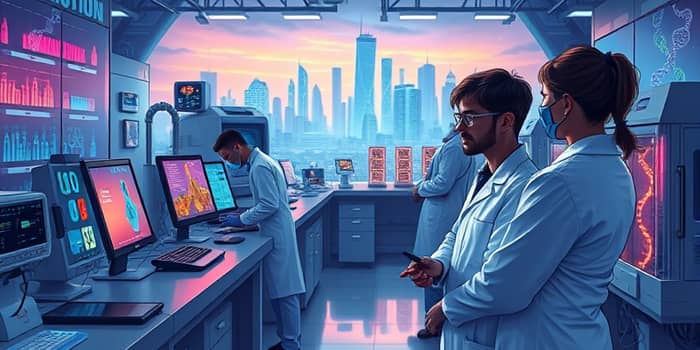
The biotechnology sector is undergoing an unprecedented transformation. Rapid advances in research, investment flows, and technological breakthroughs are reshaping the industry’s landscape, creating a new generation of leaders poised to revolutionize healthcare, agriculture, and industry. This comprehensive analysis explores the forces propelling this growth and highlights the companies, trends, and challenges that will define biotech’s next chapter.
Over the past decade, the global biotechnology market is forecasted to expand at a remarkable pace. Analysts estimate the market will reach USD 5.85 trillion by 2034, growing at a 13.6% CAGR between 2025 and 2034. Today, the sector’s market capitalization exceeds USD 6 trillion, with U.S. companies representing more than half that total value. In June 2025 alone, the top 25 public biotech firms boasted a combined market cap of USD 1.909 trillion—an 11.6% year-over-year increase.
Such growth has real-world economic consequences. The biotech ecosystem now comprises over 107,000 companies and more than 5,800 startups focused on pioneering therapies and products. Last year, industry employment surged, adding over 740,000 new jobs and bringing global sector employment to 13.2 million. This expansion fuels local economies, especially in innovation hubs like San Francisco, Boston, London, and Berlin.
At the heart of biotech’s rise are transformative innovations that accelerate discovery and development. From computational algorithms to biofabrication, these tools are dismantling traditional barriers to entry, enabling smaller players to compete on a global stage.
Advances in machine learning have given rise to revolutionary AI-driven drug discovery platforms that screen millions of compounds in days rather than months. Concurrently, genome editing and proteomic profiling are enabling precision and speed of therapeutic development previously thought impossible. In agri-biotech, engineered seeds now cover over 88.6 million acres of U.S. farmland, boosting yields while reducing pesticide use.
While established giants like Novo Nordisk (USD 300B market cap) and AbbVie (USD 260B) remain dominant, rapid growth stories are emerging from unexpected corners. Nurix Therapeutics achieved 332% growth by pioneering targeted protein modulation therapies, advancing its NX-0479 candidate into clinical trials. Y-mAbs Therapeutics saw a 308.8% surge by focusing on pediatric cancer antibodies, demonstrating 60% disease control rates in trials. Meanwhile, JA Saúde Animal in Brazil led the agri-biotech charge with 149.2% growth, and Vertex Pharmaceuticals continued to innovate in cystic fibrosis and stem cell-derived diabetes treatments.
This table illustrates the dramatic growth achieved by both niche innovators and established leaders. Such performance underscores biotech’s unique capacity to reward bold research and strategic partnerships.
Vital to this momentum are robust investment streams. Leading venture firms and corporate backers—Bayer, Arch Venture Partners, and OrbiMed—have collectively deployed over USD 50 billion across biotech ventures. In recent years, there have been 98,000 funding rounds, averaging USD 47.7 million each, supporting more than 23,000 companies around the globe.
Such capital infusion is matched by vigorous policy efforts to cultivate innovation-friendly environments. Government incentives for spinouts, fast-track approval pathways, and capital market reforms are aligning to fuel next-generation biotech companies.
Despite its promise, the sector faces nontrivial challenges. Regulatory bodies must balance accelerated approval programs with rigorous post-market surveillance and safety protocols. Additionally, the dual-use nature of biotech—where the same tools that cure diseases could be misused—demands robust biosecurity measures and international cooperation.
Scaling from lab benches to commercial production often exposes companies to manufacturing hurdles, supply chain complexities, and workforce shortages. Yet regions that foster collaboration between academia, investors, and regulators are thriving, creating fertile ground for the next biotech titans.
Looking ahead, transformative power of biotechnological advances will continue to unlock therapies for rare diseases, sustainable agricultural solutions, and bio-based materials. As expert voices note, regions that successfully combine innovation, investment, and supportive policy environments are poised to produce the next generation of trillion-dollar companies.
The convergence of cutting-edge science, abundant capital, and strategic policy is charting a course toward unprecedented industry leadership. From AI-driven drug discovery hubs to agri-biotech innovators, a diverse array of companies is rising to prominence. Their collective impact on global health, food security, and economic growth cannot be overstated.
As we embrace this dynamic era, stakeholders—from scientists and entrepreneurs to investors and policymakers—must remain vigilant, ethical, and collaborative. By doing so, we ensure that the powerful tools of biotechnology serve humanity’s greatest needs, ushering in a future where new sector leaders deliver breakthroughs that change lives worldwide.
References













